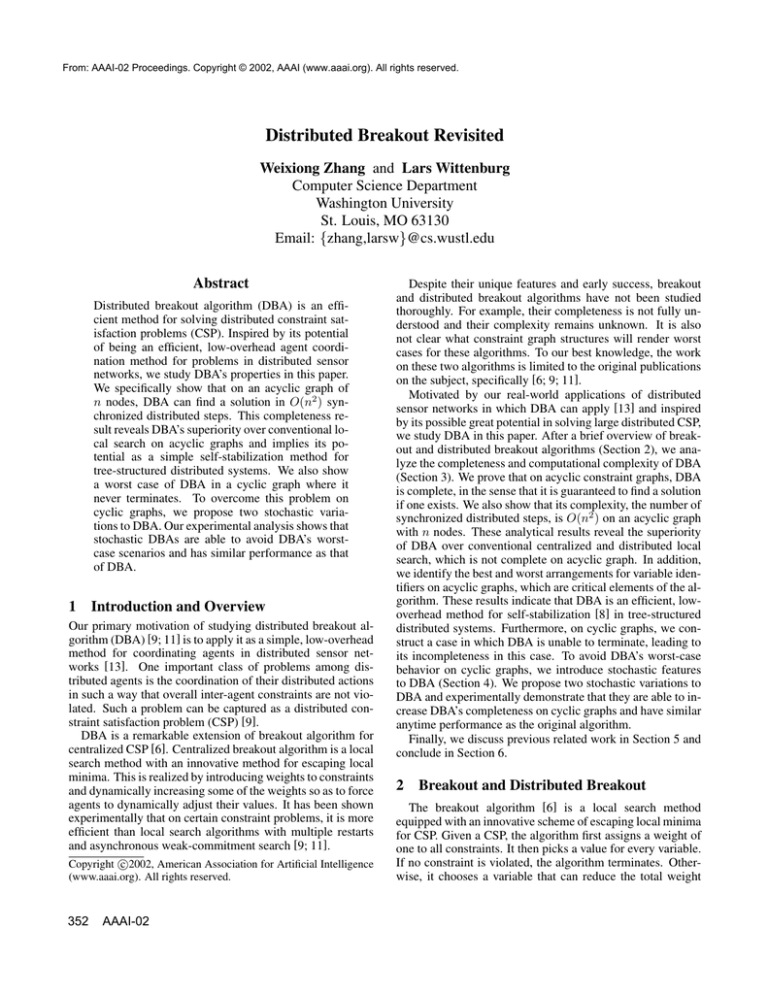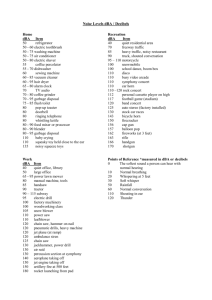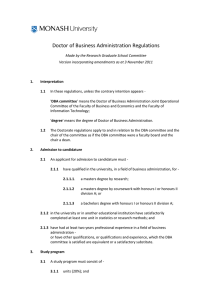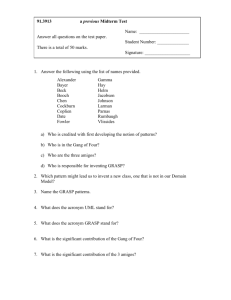Distributed Breakout Revisited Weixiong Zhang Abstract Computer Science Department
advertisement

From: AAAI-02 Proceedings. Copyright © 2002, AAAI (www.aaai.org). All rights reserved.
Distributed Breakout Revisited
Weixiong Zhang and Lars Wittenburg
Computer Science Department
Washington University
St. Louis, MO 63130
Email: {zhang,larsw}@cs.wustl.edu
Abstract
Distributed breakout algorithm (DBA) is an efficient method for solving distributed constraint satisfaction problems (CSP). Inspired by its potential
of being an efficient, low-overhead agent coordination method for problems in distributed sensor
networks, we study DBA’s properties in this paper.
We specifically show that on an acyclic graph of
n nodes, DBA can find a solution in O(n2 ) synchronized distributed steps. This completeness result reveals DBA’s superiority over conventional local search on acyclic graphs and implies its potential as a simple self-stabilization method for
tree-structured distributed systems. We also show
a worst case of DBA in a cyclic graph where it
never terminates. To overcome this problem on
cyclic graphs, we propose two stochastic variations to DBA. Our experimental analysis shows that
stochastic DBAs are able to avoid DBA’s worstcase scenarios and has similar performance as that
of DBA.
1 Introduction and Overview
Our primary motivation of studying distributed breakout algorithm (DBA) [9; 11] is to apply it as a simple, low-overhead
method for coordinating agents in distributed sensor networks [13]. One important class of problems among distributed agents is the coordination of their distributed actions
in such a way that overall inter-agent constraints are not violated. Such a problem can be captured as a distributed constraint satisfaction problem (CSP) [9].
DBA is a remarkable extension of breakout algorithm for
centralized CSP [6]. Centralized breakout algorithm is a local
search method with an innovative method for escaping local
minima. This is realized by introducing weights to constraints
and dynamically increasing some of the weights so as to force
agents to dynamically adjust their values. It has been shown
experimentally that on certain constraint problems, it is more
efficient than local search algorithms with multiple restarts
and asynchronous weak-commitment search [9; 11].
c
Copyright 2002,
American Association for Artificial Intelligence
(www.aaai.org). All rights reserved.
352
AAAI-02
Despite their unique features and early success, breakout
and distributed breakout algorithms have not been studied
thoroughly. For example, their completeness is not fully understood and their complexity remains unknown. It is also
not clear what constraint graph structures will render worst
cases for these algorithms. To our best knowledge, the work
on these two algorithms is limited to the original publications
on the subject, specifically [6; 9; 11].
Motivated by our real-world applications of distributed
sensor networks in which DBA can apply [13] and inspired
by its possible great potential in solving large distributed CSP,
we study DBA in this paper. After a brief overview of breakout and distributed breakout algorithms (Section 2), we analyze the completeness and computational complexity of DBA
(Section 3). We prove that on acyclic constraint graphs, DBA
is complete, in the sense that it is guaranteed to find a solution
if one exists. We also show that its complexity, the number of
synchronized distributed steps, is O(n2 ) on an acyclic graph
with n nodes. These analytical results reveal the superiority
of DBA over conventional centralized and distributed local
search, which is not complete on acyclic graph. In addition,
we identify the best and worst arrangements for variable identifiers on acyclic graphs, which are critical elements of the algorithm. These results indicate that DBA is an efficient, lowoverhead method for self-stabilization [8] in tree-structured
distributed systems. Furthermore, on cyclic graphs, we construct a case in which DBA is unable to terminate, leading to
its incompleteness in this case. To avoid DBA’s worst-case
behavior on cyclic graphs, we introduce stochastic features
to DBA (Section 4). We propose two stochastic variations to
DBA and experimentally demonstrate that they are able to increase DBA’s completeness on cyclic graphs and have similar
anytime performance as the original algorithm.
Finally, we discuss previous related work in Section 5 and
conclude in Section 6.
2 Breakout and Distributed Breakout
The breakout algorithm [6] is a local search method
equipped with an innovative scheme of escaping local minima
for CSP. Given a CSP, the algorithm first assigns a weight of
one to all constraints. It then picks a value for every variable.
If no constraint is violated, the algorithm terminates. Otherwise, it chooses a variable that can reduce the total weight
Algorithm 1 Sketch of DBA
set the local weights of constraints to one
value ← a random value from domain
while (no termination condition met) do
exchange value with neighbors
WR ← BestPossibleWeightReduction()
send WR to neighbors and collect their WRs
if (WR > 0) then
if (it has the biggest improvement among neighbors)
then
value ← the value that gives WR
end if
else
if (no neighbor can improve) then
increase violated constraints’ weights by one
end if
end if
end while
of the unsatisfied constraints if its value is changed. If such
a weight-reducing variable-value pair exists, the algorithm
changes the value of a chosen variable. The algorithm continues the process of variable selection and value change until no weight-reducing variable can be found. At that point,
it reaches a local minimum if a constraint violation still exists. Instead of restarting from another random initial assignment, the algorithm tries to escape from the local minimum
by increasing the weights of all violated constraints by one
and proceeds as before. This weight change will force the
algorithm to alter the values of some variables to satisfy the
violated constraints.
Centralized breakout can be extended to distributed breakout algorithm (DBA) [9; 11]. Without loss of generality, we
assign an agent to a variable, and assume that all agents have
unique identifiers. Two agents are neighbors if they share a
common constraint. An agent communicates only with its
neighbors. At each step of DBA, an agent exchanges its current variable value with its neighbors, computes the possible
weight reduction if it changes its current value, and decides
if it should do so. To avoid simultaneous variable changes
at neighboring agents, only the agent having the maximal
weight reduction has the right to alter its current value. If
ties occur, the agents break the ties based on their identifiers.
The above process of DBA is sketched in Algorithm 1. For
simplicity, we assume each step is synchronized among the
agents. This assumption can be lifted by a synchronization
mechanism [8].
In the description of [9; 11], each agent also maintains a
variable, called my-termination-counter (MTC), to help detect a possible termination condition. At each step, an agent’s
MTC records the diameter of a subgraph centered around the
agent within which all the agents’ constraints are satisfied.
For instances, an agent’s MTC is zero if one of its neighbors
has a violated constraint; it is equal to one when its immediate neighbors have no violation. Therefore, if the diameter of
the constraint graph is known to each agent, when an agent’s
MTC is equal to the known diameter, DBA can terminate with
the current agent values as a satisfying solution. However,
MTCs may never become equal to the diameter even if a solution exists. There are cases in which the algorithm is not
complete in that it cannot guarantee to find a solution even if
one exists. Such a worst case depends on the structure of a
problem, a topic of the next section. We do not include the
MTC here to keep our description simple.
It is worth pointing out that the node, or agent, identifiers
are not essential to the algorithm. They are only used to set up
a priority between two competing agents for tie breaking. As
long as such priorities exists, node identifiers are not needed.
3 Completeness and Complexity
In this section, we study the completeness and computational
complexity of DBA on binary constraint problems in which
no constraint involves more than two variables. This is not
a restriction as a non-binary constraint problem can be converted to a binary one with cycles [1; 7]. One advantage of using binary problems is that we can focus on the main features
of DBA rather than pay attention to the degree of constraints
of the underlying problem. In the rest of the paper, we use
constraint problems to refer to binary problems if not explicitly stated. In addition, the complexity is defined as DBA’s
number of synchronized distributed steps. In one step, value
changes at different nodes are allowed while one variable can
change its value at most once. We also use variables, nodes
and agents interchangeably in our discussion.
3.1 Acyclic graphs
First notice that acyclic graphs are 2-colorable. Thus, any
acyclic constraint problem must have a satisfying solution if
the domain size of a variable is at least two. In addition, larger
domains make a problem less constrained. Therefore, it is
sufficient to consider acyclic constraint problems with variable domains no more than two.
To simplify our discussion and for pedagogical reasons, we
first consider chains, which are special acyclic graphs. The
results on chains will also serve as a basis for trees.
Chains
We will refer to the combination of variable values and constraint weights as a problem state, or state for short. A solution of a constraint problem is a state with no violated constraint. We say two states are adjacent if DBA can move from
one state to the other within one step.
Lemma 1 On a chain, DBA will not visit the same problem
state more than once.
Proof: Assume the opposite, i.e., DBA can visit a state twice
in a process as follows, Sx → Sy → · · · → Sz → Sx . Obviously no constraint weight is allowed to increase at any state
on this cycle. Suppose that node x changes its value at state
Sx to resolve a conflict C involving x. In the worst case a
new conflict at the other side of the node will be created. C
is thus “pushed” to the neighbor of x, say y. Two possibilities exist. First, C is resolved at y or another node along the
chain, so that no state cycle will form. Second, C returns to
x, causing x to change its value back to its previous value.
Since nodes are ordered, i.e., they have prioritized identifiers,
AAAI-02
353
violations may only move in one direction and C cannot return to x from y without changing a constraint weight. This
means that C must move back to x from another path, which
contradicts the fact that the structure is a chain. Lemma 2 On a chain of n variables, each of which has a domain size at least two, DBA can increase a constraint weight
to at most n/2.
Proof: The weight of the first constraint on the left of the
chain will never change and thus remain at one, since the left
end node can always change its value to satisfy its only constraint. The weight of the second constraint on the left can
increase to two at the most. When the weight of the second
constraint is two and the second constraint on the left is violated, the second node will always change its value to satisfy
the second constraint because it has a higher weight than the
first constraint. This will push the violation to the left end
node and force it to change its value and thus resolve the conflict. This argument can be inductively applied to the other
internal nodes and constraints along the chain. In fact, it can
be applied to both ends of the chain. So the maximal constraint weight on the chain will be n/2. Immediate corollaries of this lemma are the best and worst
arrangements of variable identifiers. In the best case, the end
nodes of the chain should be most active, always trying to
satisfy the only constraint, and resolving any conflict. Therefore, the end nodes should have the highest priority, followed
by their neighbors, and so on to the middle of the chain. The
worst case is simply the opposite of the best case; the end
nodes are most inactive and have the lowest priority, followed
by their neighbors, and so on.
Theorem 1 On a chain of n nodes, DBA terminates in at
most n2 steps with a solution, if it exists, or with an answer
of no solution, if it does not exist.
Proof: As a chain is always 2-colorable, the combination of
the above lemmas gives the result for a chain with nodes of
domain sizes at least two. It is possible, however, that no
solution exists if some variables have domain sizes less than
two. In this case, it is easy to create a conflict between two
nodes with domain size one, which will never be resolved.
As a result, the weights of the constraints between these two
nodes will be raised to n. If each agent knows the chain length
n, DBA can be terminated when a constraint weight is more
than n. (In fact, the chain length can be computed in O(n)
steps as follows. An end node first sends number 1 to its only
neighbor. The neighboring node adds one to the number received and then passes the new number to the other neighbor.
The number reached at the other end of the chain is the chain
length, which can be subsequently disseminated to the rest of
the chain. The whole process takes 2n steps.) Furthermore, a
node needs at most n−1 steps to increase a constraint weight.
This worst case occurs when a chain contains two variables
at two ends of the chain which have the lowest priorities and
unity domain sizes so neither of them can change its value.
On such a chain, a conflict can be pushed around between the
two end nodes many time. Every time a conflict reaches an
end node, the node increases the constraint weight to push the
354
AAAI-02
conflict back. Since a constraint weight will be no more than
n, the result follows. A significant implication of these results is a termination
condition for DBA on a chain. If DBA does not find a solution
in n2 steps, it can terminate with an answer of no solution.
This new termination condition and DBA’s original termination condition of my-termination-counter guarantee DBA to
terminate on a chain.
Trees
The key to the proof for the chain and tree structures is that no
cycle exists in an acyclic graph, so that the same conflict cannot return to a node without increasing a constraint weight.
The arguments on the maximal constraint weight for chains
hold for general acyclic graphs or trees. First consider the
case that each variable has a domain size at least two. In an
acyclic graph, an arbitrary constraint (link) C connects two
disjoint acyclic graphs, G1 and G2 . Assume G1 and G2 have
n1 and n2 nodes, respectively, and n1 ≤ n2 . Then the maximal possible weight W on C cannot be more than n1 , which
is proven inductively as follows. If the node v associated with
C is the only node of G1 , then the claim is true since v can
always accommodate C. If G1 is a chain, then the arguments
for Lemma 2 apply directly and the maximal possible weight
of a constraint is the number of links the constraint is away
from the end variable of G1 . If v is the only node in G1 that
connects to more than one constraint in G1 , which we call a
branching node, then a conflict at C may be pushed into G1
when the weight of C is greater than the sum of the weights
of all constraints in G1 linked to v, which is at most equal to
the number of nodes of G1 . The same arguments equally apply when v is not the only branching node of G1 . Therefore,
the maximal constraint weight is bounded by n.
The worst-case complexity can be derived similarly. A
worst case occurs when all end variables of an acyclic graph
have fixed values, so that a conflict may never be pushed out
of the graph. A constraint weight can be bumped up by one
after a conflict has traveled from an end node to other end
nodes and back, within at most n steps.
Based on these arguments, we have the following result.
Theorem 2 On an acyclic graph with n nodes, DBA terminates in at most n2 steps with either an optimal solution, if it
exists, or an answer of no solution, if it does not exist.
The above completeness result can be directly translated to
centralized breakout algorithm, leading to its completeness
on acyclic graphs as well. Moreover, since each step in DBA
is equivalent to n steps in the centralized algorithm, each of
which examines a distinct variable, the complexity result on
DBA also means that the worst-case complexity of the centralized algorithm is O(n3 ). These analytical results reveal
the superiority of centralized breakout algorithm and DBA
over conventional local search methods on acyclic graphs,
which are not complete even on a chain.
Our experimental results also show that the number of steps
taken by DBA is much smaller than the n2 upper bound, as
shown in Figure 1. In our experiments, we used different
size chains and trees and averaged the results over 100 random trials. We considered the best- and worst-case identi-
good ordering
branching factor 2
100
10
branching factor 6
10
100
1000
12
DBA(sp)
10
8
DBA
DBA(wp)
6
1
10 20 30 40 50 60 70 80 90 100
chain length
DBA
DBA(wp)
DBA(sp)
14
number of steps
worst ordering
16
branchin factor 2
branchin factor 6
1000
number of steps
10000
perfect ordering
worst ordering
number of steps
number of steps
350
300
250
200
150
100
50
0
10000
number of nodes
4
0.1 0.2 0.3 0.4 0.5 0.6 0.7 0.8 0.9
probability of DBA(wp/sp)
1
22
DBA(wp)
21
DBA(sp)
20
19
18
DBA(wp)
17
16
DBA(sp)
15
14
13
0.1 0.2 0.3 0.4 0.5 0.6 0.7 0.8 0.9
probability of DBA(wp/sp)
1
Figure 1: The number of steps taken by DBA on chains with
the best and worst variable identifier arrangements (left) and
on trees with worst identifier arrangements (right).
Figure 3: Steps taken by DBA and variants on the example of
Figure 2 with random initial assignments (left) and the specific assignment of Figure 2 (right).
fier arrangements for chains (Figure 1 left) and worst-case arrangement for trees (where more active nodes are closer to the
centers of the trees) with different branching factors. As the
figure shows, the average number of steps taken by DBA is
near linear for the worst-case identifier arrangement, and the
number of steps is linear on trees with a worst-case identifier
arrangement (Figure 1 right). Furthermore, for a fixed number of nodes the number of steps decreases inversely when
branching factors of the trees increase. In short, DBA is efficient on acyclic graphs.
to 2. This process can continue forever with the two conflicts
moving in the same direction on the chain at the same speed,
chasing each other endlessly and making DBA incomplete.
3.2 Cyclic graphs
Unfortunately, DBA is not complete on cyclic constraint
graphs. This will include non-binary problems as they can be
converted to binary problems with cycles. This is also the reason that breakout algorithm is not complete on Boolean satisfiability with three variables per clause [6], which is equivalent to a constraint with three variables.
2
2
1.)
2.)
1
2
3
5
8
6
4
3.)
3
5
2
2
3
2
5
2
5
4
2
5
2
2
2
4
2
2
3
8
5
2
2
2
2
1
2
4
2
7
8
2
6
2
3
7
2
6
6
4
8.)
1
2
7
8
6
7
5
2
2
3
7
8
4
7.)
1
2
3
8
6
2
2
6.)
1
2
1
2
7
2
5.)
3
8
6
4
2
2
4.)
1
2
7
7
8
1
2
5
4
2
2
2
2
6
2
Figure 2: A worst case for DBA on a ring.
When there are cycles in a graph, conflicts may walk on
these cycles forever. To see this, consider a problem of coloring a ring with an even number of nodes using two colors
(black and white), as shown in Figure 2, where the node identifiers and constraint weights are respectively next to nodes
and edges. Figure 2(1) shows a case where two conflicts appear at locations between nodes 1 and 3 and between nodes 4
and 5, that are not adjacent to each other. The weights of the
corresponding edges are increased accordingly in Figure 2(2).
As node 1 (node 4) has a higher priority than node 3 (node 5),
it changes its value and pushes the conflict one step counterclockwise in Figure 2(3). The rest of Figure 2 depicts the subsequent steps until all constraint weights have been increased
4 Stochastic Variations
A lesson that can be learned from the above worst-case scenario is that conflicts should not move at the same speed. We
thus introduce randomness to alter the speeds of possible conflict movements on cycles of a graph. This stochastic feature
may increase DBA’s chances of finding a solution possibly
with a penalty on convergence to solution for some cases.
4.1 DBA(wp) and DBA(sp)
We can add randomness to DBA in two ways. In the first, we
use a probability for tie breaking. The algorithm will proceed
as before, except that when two neighboring variables have
the same improvement for the next step, they will change their
values probabilistically. This means that both variables may
change or not change, or just one of them. We call this variation weak probabilistic DBA, denoted as DBA(wp).
In the second method, which was inspired by the distributed stochastic algorithm [3; 4; 12], a variable will change
if it has the best improvement among its neighbors. However, when it can improve but the improvement is not the best
among its neighbors, it will change based on a probability.
This variation is more active than DBA and the weak probabilistic variation. We thus call it strong probabilistic DBA,
DBA(sp) for short.
One favorable feature of these variants is that no variable
identifiers are needed, which may be important for some applications where node identifiers across the whole network
is expensive to compute. Moreover, these variants give two
families of variations to DBA, depending on the probabilities
used. It will be interesting to see how they vary under different parameters, the topic that we consider next.
4.2 DBA(wp) versus DBA(sp)
We first study the two variants on the example of coloring an
8-node ring of Figure 2. In the first set of tests, node identifiers and initial colors are randomly generated and 10,000 trials are tested. DBA is unable to terminate on 15% of the total
trials after more than 100,000 steps1 , while on the other 85%
1
Our additional tests also show that DBA’s failure rate decreases
as the ring size increases.
AAAI-02
355
1
10
100
steps
1000
DBA(sp) p=0.5
DBA(sp) p=0.9
1
10
100
1000
steps
Figure 4: DBA(wp) and DBA(sp) on grid 20 × 20 and k = 4.
of the trials DBA finds a solution after 5 steps on average as
shown in Figure 3(left). In contrast, DBA(wp) and DBA(sp)
always find solutions but require almost twice as many steps
on average with the best probability around 0.6.
In the second set of tests, we use the exact worst-case initial
assignment as shown in Figure 2. As expected, DBA failed to
terminate. DBA(wp) and DBA(sp) find all solutions on 1,000
trials. Since they are stochastic, each trial may run a different
number of steps. The average number of steps under different
probability is shown in Figure 3(right).
Next we study these two families of variants on grids,
graphs and trees. We consider coloring these structures using 2 colors. For grids, we consider 20 × 20, 40 × 40, and
60 × 60 grids with connectivities equal to k = 4 and k = 8.
To simulate infinitely large grids in our experiments, we remove the grid boundaries by connecting the nodes on the top
to those on the bottom as well as the nodes on the left to those
on the right of the grids to create k = 4 grid. For k = 8 grid,
we further link a node to four more neighbors, one each to
the top left, top right, bottom left and bottom right. This renders the problem overconstrained for two-coloring. Hence,
the algorithms may only try to improve the solution quality
by minimizing the number of violated constraints.
The results of 20 × 20 grids with k = 4 are shown in
Figure 4, averaged over 2,000 trials. As the figures show,
the higher the probability the better DBA(wp)’s performance.
For DBA(sp) p = 0.5 is the best probability.
We generate 2,000 graphs with 400 nodes with an average connectivity per node equal to k = 4 and k = 8
by adding, respectively, 1,600 and 3,200 edges to randomly
picked pairs of unconnected nodes. These two graphs are
generated to make a correspondence to the grid structures
of k = 4 and k = 8 considered previously, except that
both random graphs are not two-colorable. All algorithms
are applied to the same set of graphs for a meaningful comparison. Figure 5 shows the results on graphs with k = 8.
There is no significant difference within the DBA(wp) family. However, DBA(sp) with large probabilities can significantly degrade to very poor performance, exhibiting a phenomenon similar to phase transitions. Since DBA(sp) with
high probability is close to distributed stochastic algorithm [3;
4; 12], the results here are in line with those of [12].
We also consider DBA(wp) and DBA(sp) on random trees
with various depths and branching factors. Due to space limitations, we do not include detailed experimental results here,
but give a brief summary. As expected, they all find optimal solutions for all 10,000 2-coloring instances. Within
DBA(wp) family, there is no significant difference. However,
356
AAAI-02
1700
1600
1500
1400
1300
1200
1100
1000
900
800
DBA(wp) p=0.1
DBA(wp) p=0.5
DBA(wp) p=0.9
DBA(wp) p=0.1
DBA(wp) p=0.5
violations
DBA(wp) p=0.1
DBA(wp) p=0.1
DBA(wp) p=0.5
DBA(sp)DBA(wp)
p=0.1 p=0.9
DBA(wp) p=0.9
1
10
100
steps
2800
2600
2400
2200
2000
1800
1600
1400
1200
1000
800
DBA(sp) p=0.9
DBA(sp) p=0.1
DBA(sp) p=0.5
1
1000
10
100
steps
1000
10000
Figure 5: DBA(wp) (left) and DBA(sp) (right) on graph with
400 nodes and k=8.
number of violations
DBA(wp) p=0.5
900
800
700
600
500
400
300
200
100
0
violations
DBA(wp) p=0.1
DBA(wp) p=0.5
DBA(wp)
p=0.9 p=0.9
DBA(wp)
violations
violations
900
800
700
600
500
400
300
200
100
0
900
800
700
600
500
400
300
200
100
0
DBA
DBA(wp) p=0.9
DBA(sp) p=0.5
DBA(sp) p=0.5
DBA
DBA(wp) p=0.9
1
10
100
number of steps
Figure 6: DBA and random DBAs on grid 20 × 20 and k = 4.
DBA(sp) with a high probability has a poor anytime performance.
Combining all the results on the constraint structures we
considered, DBA(sp) appears to be a poor algorithm in some
cases, especially when its probability is very high.
4.3 DBA(wp) and DBA(sp) versus DBA
The remaining issue is how DBA(wp) and DBA(sp) compare
with DBA. Here we use the best parameters for these two
variants from the previous tests and compare them directly
with DBA. We average the results over the same sets of problem instances we used in Section 4.2. Figures 6, 7 and 8
show the experimental results on grids, random graphs and
trees, respectively. With their best parameters, DBA(wp) and
DBA(sp) appear to be compatible with DBA. Furthermore, as
discussed earlier, DBA(wp) and DBA(sp) increase the probability of convergence to optimal solutions. DBA(wp), in particular, is a better alternative in many cases if its probability
is chosen carefully. Stochastic features do not seem to impair DBA’s anytime performance on many problem structures
and help overcome the problem of incompleteness of DBA on
graphs with cycles.
5 Related Work and Discussions
It is well known that acyclic constraint problems can be
solved in linear time by an arc consistency algorithm followed by a backtrack-free value assignment [5]. However,
on acyclic graphs there exists no uniform distributed algorithm that is self-stabilizable in the sense that it is guaranteed to reach a solution from an arbitrary initial state [2].
In a uniform distributed algorithm [8], all nodes execute the
same procedure and two nodes do not differentiate themselves. Therefore, DBA is not a uniform algorithm as two
adjacent nodes can differ from each other by their different
priorities. It has also been shown that by introducing only one
unique node to a constraint graph, an exponential-complexity
number of violations
1700
1600
1500
1400
1300
1200
1100
1000
900
800
DBA
DBA(wp) p=0.9
DBA(sp) p=0.5
1
10
100
number of steps
1000
violations
Figure 7: DBA and random DBAs on graph with 400 nodes
and k=8.
90
80
70
60
50
40
30
20
10
0
DBA
DBA
DBA(wp) p=0.9
DBA(sp) p=0.5
Acknowledgment
DBA(sp) p=0.5
DBA(wp) p=0.9
1
10
as it shows the superiority of DBA over conventional local
search, which does not guarantee the completeness even on
a chain. The result also implies that DBA can be used as
a method for self stabilization in tree-structured distributed
systems. We also identified a simple worst-case node identifier arrangement on a ring in which DBA may not terminate.
This helps to understand the behavior of DBA on graphs and
non-binary constraint problems. We further proposed and experimentally demonstrated that randomization can overcome
such worst-case situations without a significant penalty to
DBA’s anytime performance.
100
steps
Figure 8: DBA and random DBAs on tree with depth d = 4
and branching factor k = 4.
self-stabilization algorithm exists [2]. In that regard, our results of DBA on acyclic graph indicate that node priorities are
merely a tool for reducing complexity.
One related algorithm for distributed CSP is asynchronous
weak-commitment (AWC) search algorithm [9; 10]. One
major difference between AWC and DBA is that node priorities in AWC may change dynamically while node priorities in DBA are stationary. In contrast, constraint weights
may increase dynamically in DBA while they are static in
AWC. With a sufficient amount of memory to record the
states (agent views) that an agent has visited, AWC is guaranteed to converge to a solution if it exists. In the worst case,
the amount of memory required is exponential of the problem size. In contrast, DBA converges to a solution on acyclic
graphs without any additional memory. It may be also the
case that AWC does not require an exponential amount of
memory to reach a solution on acyclic graph, an interesting
future research topic.
Another related algorithm for distributed CSP is distributed
stochastic algorithm (DSA) [3; 4; 12]. DSA is a family of
stochastic search algorithms with two members being different from each other on the degrees of parallelism of agent
actions. Contrasting to DBA, DSA does not require priorities
among agents and is not guaranteed to find a solution either,
even if one exists. Our limited experimental results showed
that DBA is more efficient than DSA on acyclic graphs, which
is supported by our analytical results in this paper, and on
many underconstrained cyclic constraint problems. Our complete results comparing these two algorithms will be included
in our final report of this research.
6 Conclusions
We closely examined the completeness and computational
complexity of distributed breakout algorithm (DBA) in this
paper. We showed that DBA is complete and has low polynomial complexity on acyclic graphs. This result is important
This research was funded in part by NSF Grants IIS-0196057
and IET-0111386, and in part by DARPA Cooperative Agreements F30602-00-2-0531 and F33615-01-C-1897. Thanks to
Stephen Fitzpatrick, Guandong Wang and Zhao Xing for discussions and to the anonymous referees for comments.
References
[1]
[2]
[3]
[4]
[5]
[6]
[7]
[8]
[9]
[10]
[11]
[12]
[13]
F. Bacchus and P. van Beek. On the conversion between nonbinary and binary constraint satisfaction problems. In Proc.
AAAI-98, pages 310–318, 1998.
Z. Collin, R. Dechter, and S. Katz. Self-stabilizing distributed
constraint satisfaction. Chicago Journal of Theoretical Computer Science, 3(4), 2000.
M. Fabiunke. Parallel distributed constraint satisfaction. In
Proc. Intern. Conf. on Parallel and Distributed Processing
Techniques and Applications (PDPTA-99), pages 1585–1591,
1999.
S. Fitzpatrick and L. Meertens. An experimental assessment
of a stochastic, anytime, decentralized, soft colourer for sparse
graphs. In Proc. 1st Symp. on Stochastic Algorithms: Foundations and Applications, pages 49–64, 2001.
A. K. Mackworth and E. C. Freuder. The complexity of some
polynomial network consistency algorithms for constraint satisfaction problems. Artificial Intelligence, 25:65–74, 1985.
P. Morris. The breakout method for escaping from local minima. In Proc. AAAI-93, pages 40–45.
F. Rossi, C. Petrie, and V. Dhar. On the equivalence of constraint satisfaction problems. In Proc. ECAI-90, pages 550–
556, 1990.
G. Tel. Introduction to Distributed Algorithms. Cambridge
University Press, 2000.
M. Yokoo. Distributed Constraint Satisfaction: Foundations of
Cooperation in Multi-Agent Systems. Springer Verlag, 2001.
M. Yokoo, E. H. Durfee, T. Ishida, and K. Kuwabara. The
distributed constraint satisfaction problem: formalization and
algorithms. IEEE Trans. PAMI, 10(5):673–685, 1998.
M. Yokoo and K. Hirayama. Distributed breakout algorithm
for solving distributed constraint satisfaction problems. In
Proc. ICMAS-96.
W. Zhang, G. Wang, and L. Wittenburg. Distributed stochastic
search for implicit distributed coordination: Parallelism, phase
transitions and performance. In submitted to AAAI-02 Workshop on Probabilistic Approaches in Search.
W. Zhang and L. Wittenburg. Implicit distributed coordination
in sensor networks. In Proc. AAMAS-02, to appear.
AAAI-02
357






